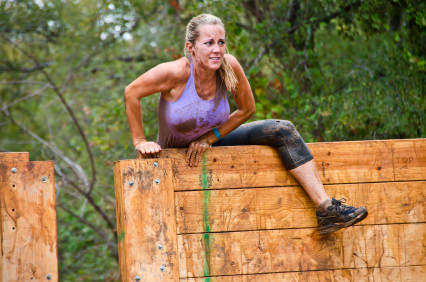|
Last summer, I surprised a few family members by asking if they wanted to form a team to do a mud run. I’m not known as adventurous—or as someone who likes to get dirty—but mud races were becoming so popular among runners (and non-runners alike) that I was ready to step out of my comfort zone and try something new. To my delight, the race was lots of fun and definitely something I’d do again in the future. Mud runs have exploded in popularity over the past decade. Today, you have no shortage of mud-related "obstacle" races from which to choose. Each race is different, so it’s important to know exactly what you’re getting into before you sign up. A few popular "dirty" obstacle races include:
.jpg) Many of these races have certain common obstacles, such as:
Every race location sets up its obstacles at different intervals. Sometimes you’ll encounter obstacles that are spaced evenly apart, say every half to full mile away from the next. Sometimes you'll encounter several obstacles in a row, or run over a mile without encountering any obstacle at all. Typically, how often you'll encounter an obstacle depends on the local terrain where the race is held—often out in the country, in fields, and even encompassing park areas that have dirt trails. I've heard a lot of people say that they "aren't worried" about the distance of the race they plan to do because it'll be broken up by obstacles. That is somewhat true, but the obstacles themselves are often no walk in the park either. You will be moving, running, climbing, pulling, wading, swimming, crawling—and essentially exerting yourself—for the duration of the race. However, some races become crowded and people have to "bottleneck" into an obstacle, which may provide a few moments—or several minutes—of rest while you wait to encounter an obstacle. But that isn't a given. It's also important to consider the time of year your race will be held and what the weather might be. Many of these races take place in early spring, late fall and even winter—which can be a bad, uncomfortable and even unsafe condition when you combine water elements and mud with cold temperatures. Others take part under beating sunlight with little to no cover during the hottest and most humid seasons and even at the height of temperatures for the day. Definitely consider these factors when signing up for a race and choosing your start time (when applicable). How to Train and Prepare for a Mud Run Mud runs are a fun way to challenge yourself and get a great workout at the same time. But how do you train for an event like this? Although events like Tough Mudder are strenuous and require much more advanced training due to their distance alone, the typical mud run of a few miles is something that the average person can complete, often with minimal preparation. (Of course completing a mud race is very different from competing in it. The more you train and the fitter you are, the faster your race time will be and the more comfortable and fun the experience will be overall.)
 Like I said before, the average mud run (between 3 and 6 miles) is something most people, with some training, can complete. Events like Tough Mudder and Spartan Race are extremely challenging and aren't something to attempt unless you're healthy, cleared for this event by your physician, and have put in a significant amount of advanced training. Don’t sign up for Tough Mudder just because it “sounds fun" unless you're fit and strong enough to run a half marathon (or able to train for that distance in the time you have available). As a runner, I'd say a half marathon is an easier task than this particular race, so if 13.1 miles sounds daunting, a Tough Mudder may not be right for you. Pushing yourself further than your body is ready to go (without adequate training) can lead to injury and a miserable experience. You wouldn’t go from running a 5K to a marathon all at once, so you want to be sure you’re in great shape to tackle the demands of one of these longer events. My advice? If a mud run sounds fun to you, try a shorter one first. Train using the guidelines listed above. And work diligently on increasing your running endurance before attempting the longer, more arduous mud races. |
Popular Entries
Related Entries
More From SparkPeople
|

.jpg)
.png)

.png)
.png)

.jpg)















.jpg)